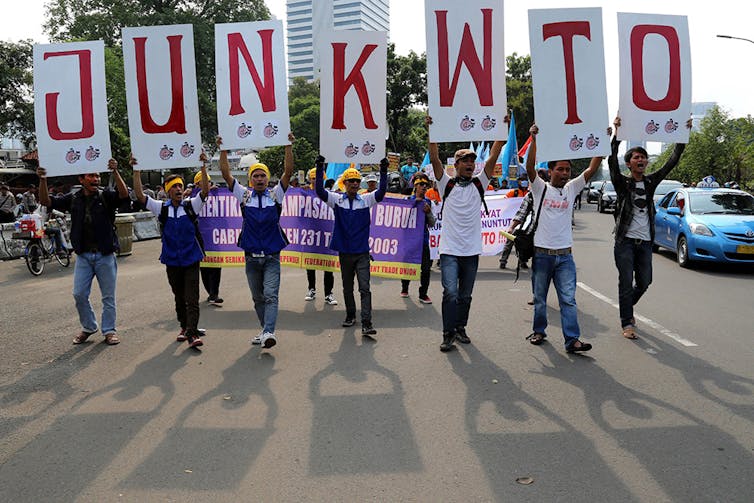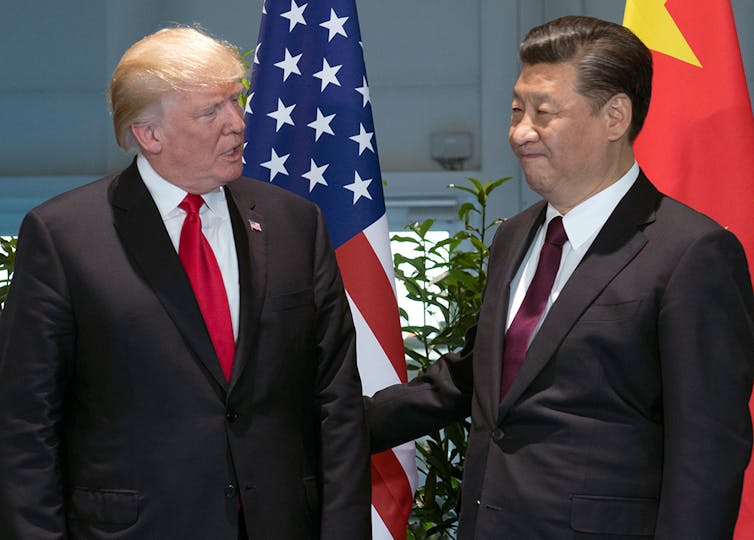Trump's go-it-alone approach to China trade ignores WTO's better way to win
- Written by Charles Hankla, Associate Professor of Political Science, Georgia State University
President Donald Trump seems to be changing his tune on trade.
On March 8, he imposed across-the-board tariffs[1] on the importation of steel and aluminum, angering allies[2] and adversaries alike. Exactly two weeks later, the president launched a new salvo in what could turn into an all-out trade war, this time aimed exclusively at one country: China.
Why the abrupt change in strategy? And is it a good thing?
The answers to both questions aren’t straightforward, as my own experience[3] talking to American companies doing business in China can attest.
A new approach
The president’s originally indiscriminate steel and aluminum tariffs – of 25 percent and 10 percent respectively – received immediate pushback[4] from many quarters, including U.S. industries dependent on the metals and key trading partners such as Canada and the European Union.
This quickly led to exemptions[5] for a host of critical American allies[6], from Canada and Europe to South Korea and Argentina, who also all happen to be among the primary sources[7] of U.S. metal imports.
Trump’s new approach, announced March 22, is to single out[8] China with US$60 billion worth of tariffs on a much wider assortment of goods, with a list of specific items to be unveiled soon. This, coupled with the exemption policy, allows Trump to walk back his earlier, ill-advised policy while still acting tough on trade.
Most likely, the administration has come to realize that trade actions targeting China have much more support[9] from Congress and the American public.
But is this form of trade protection an improvement? In theory, it could be.
There is no denying that China sometimes fails[10] to play by the rules[11] in world trade and investment. This was driven home to me personally when I participated in a Georgia State Business School event in Atlanta some eight years ago.
The topic of the conference was trade and investment in China, and many of the participants were local business leaders. Most had an anecdote about experiencing intellectual property theft, rigged bidding processes and the like while operating in the country.
But anecdotes are not needed to make the case. The U.S. government estimates that the American economy loses over $200 billion[12] annually from Chinese intellectual property theft.
Trump’s plan to respond to this problem, however, involves the kind of unilateral retaliation - as opposed to reciprocal action[13] sanctioned by international trade law - that can lead to a trade war. In fact, there’s some evidence[14] that a dispute is already in the works.
In trade wars, each side normally accuses the other[15] of starting the conflict. Ultimately, the level of commercial aggression spirals out of control as each partner responds to the latest protectionist measures of the other.
 This seems to be a sentiment the protesters share with Trump.
AP Photo/Tatan Syuflana
This seems to be a sentiment the protesters share with Trump.
AP Photo/Tatan Syuflana
The WTO’s role
The fear of uncontrolled trade wars like this led to the incorporation of a dispute settlement process[16] when the World Trade Organization was created in 1995.
Under this process, when one country suspects another of violating its WTO commitments, it can lodge an action with the organization’s quasi-judicial body.
The WTO judges then hear arguments from both countries and determine if the complaint is justified. When they believe it is, and when the defending state refuses to change its policies, the WTO adjudicators can legalize the reciprocal imposition of tariffs up to a specified threshold.
The beauty of this procedure is that it produces a credible judgment about which country is at fault, which in turn creates reputational costs[17] for the country found to be violating its agreements. This country, if it refuses to abide by the WTO ruling, will find itself isolated internationally.
And if the violator has the temerity to retaliate against the WTO-legitimized sanctions, it risks undercutting its position in the world trading order. On top of that, the WTO procedure limits the scale of any trade war by putting a cap on the legal punishments to be imposed.
The WTO dispute settlement process has been good for the United States. Since 1995, America has brought actions[18] against 117 other WTO members, and has been on the receiving end of 136 complaints. Research shows that the U.S. tends to have better odds of winning[19] cases at the WTO than other countries. Just recently, the United States won cases against the European Union[20], India[21], Indonesia[22] and Mexico[23].
It is true that Trump has said he plans[24] to use the WTO process to contest China’s technology transfer policy. But his unilateral[25] imposition of $60 billion of tariffs on China risks not only a damaging trade war but also undercuts any chances for the U.S. to build the type of international coalition[26] necessary to force real changes.
A U.S.-China trade war, one undertaken outside the WTO process, will be seen by other countries as a fight between two powers that are equally in the wrong. Indeed, China is already moving[27] effectively to take the high ground in the dispute.
 The relationship has turned frosty since Presidents Xi and Trump met in July.
Saul Loeb/Pool Photo via AP
The relationship has turned frosty since Presidents Xi and Trump met in July.
Saul Loeb/Pool Photo via AP
The real problem
More to the point, Trump’s unilateral approach to China risks conflating the real problem of China’s intellectual property theft[28] with the broader, and more contested[29], issue of the U.S.-China trade balance.
Some economists question whether the U.S. should be worried[30] about the trade balance at all, and there is also some question about the extent that unfair Chinese practices are contributing to the problem.
Whatever the case, tariffs are not going to fix[31] the structural issues[32] contributing to the imbalance. For that, the U.S. will need to increase its competitiveness or reduce American consumption, a much taller order.
But, in the short run, there is another option. The U.S. could choose to retaliate against China’s unfair trade practices by first filing a complaint with the WTO and waiting for a ruling in its favor. This, along with American efforts to build an international coalition of countries affected by the same practices, would have a much greater chance of changing China’s behavior.
Recent statements[33] from Europe suggest that such a coalition is possible.
Working within the WTO would safeguard America’s international reputation, avoid a damaging trade war[34] and protect the legitimacy of global trade law.
The multilateral approach to this problem is clearly the right one.
References
- ^ across-the-board tariffs (theconversation.com)
- ^ angering allies (time.com)
- ^ my own experience (shared.cas.gsu.edu)
- ^ received immediate pushback (www.vox.com)
- ^ exemptions (www.nytimes.com)
- ^ critical American allies (money.cnn.com)
- ^ sources (www.trade.gov)
- ^ single out (www.nytimes.com)
- ^ more support (www.pewresearch.org)
- ^ fails (www.scmp.com)
- ^ rules (www.cbsnews.com)
- ^ American economy loses over $200 billion (money.cnn.com)
- ^ reciprocal action (www.amazon.com)
- ^ some evidence (www.nytimes.com)
- ^ each side normally accuses the other (theconversation.com)
- ^ dispute settlement process (www.wto.org)
- ^ reputational costs (press.princeton.edu)
- ^ actions (www.wto.org)
- ^ better odds of winning (www.bloomberg.com)
- ^ European Union (ustr.gov)
- ^ India (ustr.gov)
- ^ Indonesia (ustr.gov)
- ^ Mexico (thehill.com)
- ^ has said he plans (www.whitehouse.gov)
- ^ unilateral (www.nytimes.com)
- ^ coalition (www.atimes.com)
- ^ already moving (www.reuters.com)
- ^ real problem of China’s intellectual property theft (theconversation.com)
- ^ contested (www.bloomberg.com)
- ^ worried (www.cfr.org)
- ^ are not going to fix (theconversation.com)
- ^ structural issues (www.weforum.org)
- ^ statements (www.bloomberg.com)
- ^ trade war (theconversation.com)
Authors: Charles Hankla, Associate Professor of Political Science, Georgia State University


